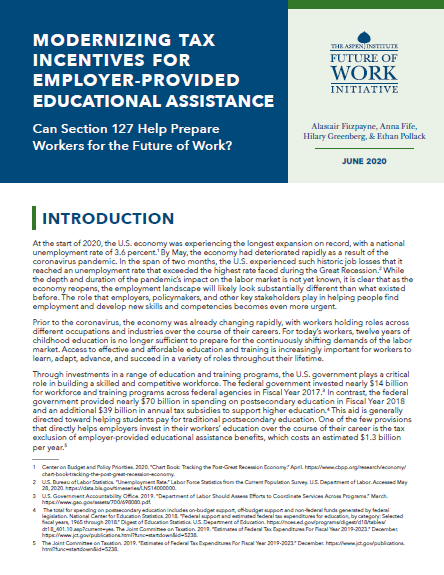Introduction
At the start of 2020, the U.S. economy was experiencing the longest expansion on record, with a national unemployment rate of 3.6 percent. By May, the economy had deteriorated rapidly as a result of the coronavirus pandemic. In the span of two months, the U.S. experienced such historic job losses that it reached an unemployment rate that exceeded the highest rate faced during the Great Recession. While the depth and duration of the pandemic’s impact on the labor market is not yet known, it is clear that as the economy reopens, the employment landscape will likely look substantially different than what existed before. The role that employers, policymakers, and other key stakeholders play in helping people find employment and develop new skills and competencies becomes even more urgent.
Prior to the coronavirus, the economy was already changing rapidly, with workers holding roles across different occupations and industries over the course of their careers. For today’s workers, twelve years of childhood education is no longer sufficient to prepare for the continuously shifting demands of the labor market. Access to effective and affordable education and training is increasingly important for workers to learn, adapt, advance, and succeed in a variety of roles throughout their lifetime.
Through investments in a range of education and training programs, the U.S. government plays a critical role in building a skilled and competitive workforce. The federal government invested nearly $14 billion for workforce and training programs across federal agencies in Fiscal Year 2017. In contrast, the federal government provided nearly $70 billion in spending on postsecondary education in Fiscal Year 2018 and an additional $39 billion in annual tax subsidies to support higher education. This aid is generally directed toward helping students pay for traditional postsecondary education. One of the few provisions that directly helps employers invest in their workers’ education over the course of their career is the tax exclusion of employer-provided educational assistance benefits, which costs an estimated $1.3 billion per year.
This exclusion for educational assistance, which is located in Section 127 of the Internal Revenue Code, offers a tax-advantaged opportunity for companies to support their employees’ pursuit of education. Added to the U.S. tax code in 1978, Section 127 provides a tax exclusion to the employee for up to $5,250 per year, paid or reimbursed by an employer, for qualified educational assistance, including tuition, fees, and books. Unlike most other spending and tax incentives for education, employer-provided educational assistance is structured on the relationship between an employee and employer, like other workplace benefits offered through employment arrangements.
Employers are well positioned to understand which skills are in demand and the programs that are effective in equipping their employees with those skills. Section 127 is one tool that can help employers encourage their employees to pursue additional education and training. The role of Section 127 in encouraging greater investment can be particularly important in times of business downturns or recessions when employers are facing pressures to cut costs and employee benefits. However, little is known about the impact of Section 127 and how it is utilized by employers and employees, largely due to a lack of comprehensive data.
As policymakers wrestle with urgent questions around how to support employers and employees in our current economy and look at specific policies that incentivize employers to reskill and upskill their employees, this issue brief aims to examine one option—Section 127. The brief provides an overview of Section 127 and background on utilization based on the available data. In addition, the issue brief discusses potential reforms that could increase investment and better target education and training for workers in a changing economy, with the goals of building a skilled and competitive workforce and creating additional opportunity for economic mobility.
The Future of Work Initiative is grateful to Lumina Foundation for providing funding for this issue brief.


